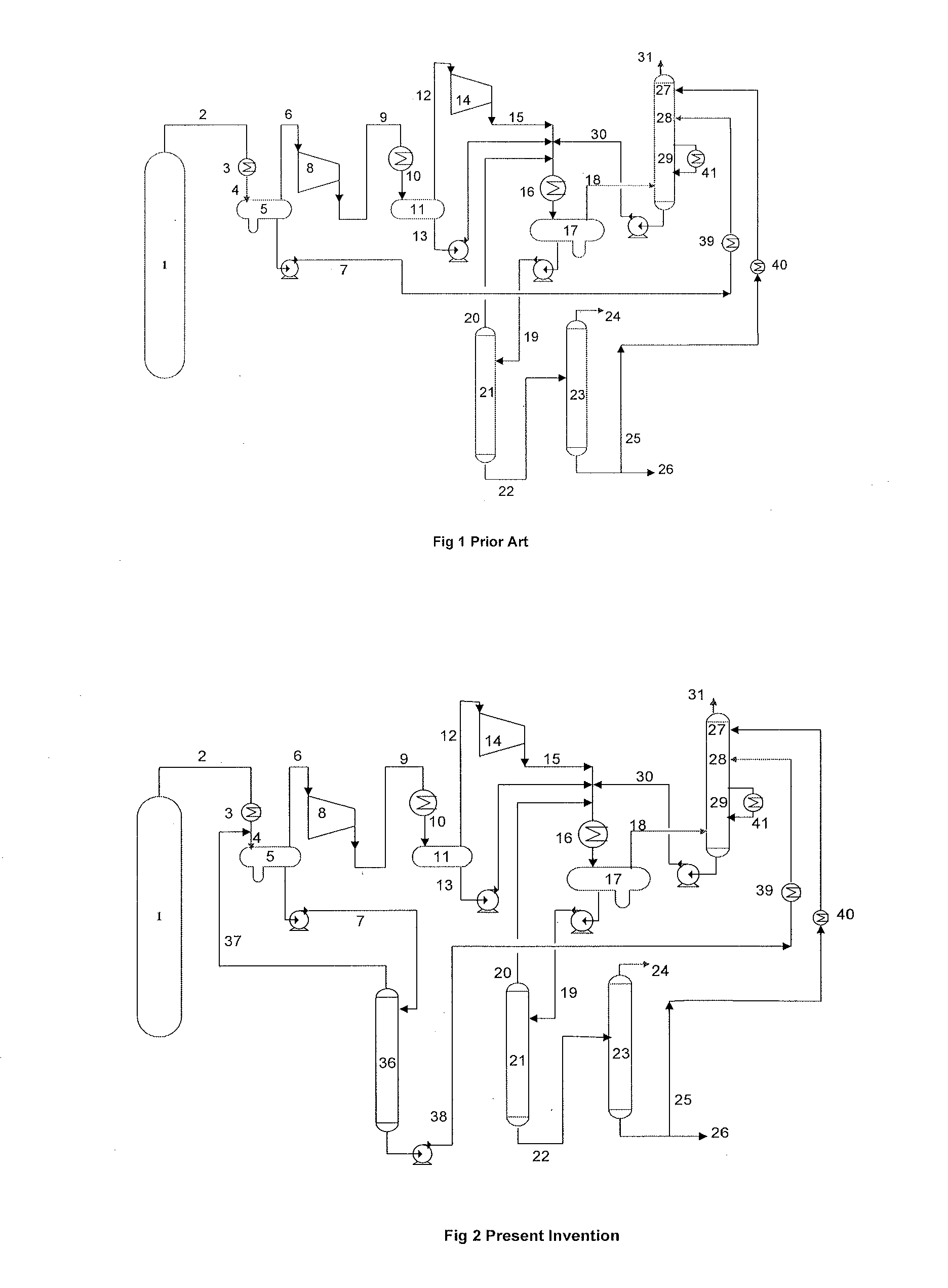Process for recovery of propylene and LPG from fcc fuel gas using stripped main column overhead distillate as absorber oil
- Summary
- Abstract
- Description
- Claims
- Application Information
AI Technical Summary
Benefits of technology
Problems solved by technology
Method used
Image
Examples
example 2
Improvement in Propylene and LPG Recovery by Using Stripped Naphtha At Lower Temperature
[0037]Stripped naphtha (as well as debut bottom recycle and absorber liquid from inter-stage coolers) is further cooled by about 8° C. using chilled water at about 20° C.
[0038]Data in Table 1 shows that chilling of lean absorber oil further reduces propylene loss to fuel gas from 1.9 to 0.44 mole % and C3-C4 loss from 2.5 to 0.68 mol %. This represents additional recovery (over the stripped naphtha case) of propylene and LPG from fuel gas due to cooling effect. It is also observed that the benefits of stripping unstabilized naphtha and chilling are additive.
example 3
Improvement in Propylene and LPG Recovery without Loading C2 Stripper, Debutanizer and the Absorber Column by Using Stripped Naphtha in Absorber
[0039]
TABLE 2UnstabilizedIncrease debutnaphthabottomas 1strecycle forlean oilStrippedsame recovery(Basenaphtha asas in strippedLiquid load parametercase)1st lean oilnaphtha casePropylene in fuel gas, mol %3.31.91.9Liquid feed to AbsorberUnsaturated naphtha / hrM10.0M1Stripped naphtha, T / hr0.00.82 M10.0Debut bottom recycle, T / hrM2M21.43 M2Total Liquid Load, T / hrM3 =0.89 M31.17 M3M1 + M2Feed to C2 stripper (T / hr)M41.002 M41.10 M4Feed to Debutanizer (T / hr)M51.004 M51.11 M5
[0040]As seen from Table 2, use of stripped naphtha has not increased liquid load (and hence vapor load) on C2 stripper, debutanizer and the absorber column while improving propylene recovery in gas concentration section.
[0041]The present invention provides a means to improve propylene recovery without loading the vapor-liquid circuit consisting of C2 stripper, debutanizer and t...
example 4
Effect of Using Stripped Naphtha on H2S Build-Up in Absorber, C2 Stripper and High Pressure Separator Loop
[0042]
TABLE 3H2S contentH2S contentin liquid1st Absorber oil used in thein feed to C2from Absorberabsorberstripper (mol %)bottom (mol %)Unstabilized naphtha @ 32° C.0.710.62(Base case)Stripped naphtha @ 32° C.0.670.55Stripped naphtha @ 24° C.0.750.68
[0043]Use of stripped naphtha in absorber reduces the build up of H2S in the liquid feed to the stripper. H2S content of the liquid feed to the C2 stripper is brought down to 0.67 mol % from base value of 0.71 mol % as seen in table 3. This can be explained by lower absorption of H2S in the absorber by use of the stripped naphtha, as reflected in lower H2S content of liquid coming out from the absorber bottom (0.55 mol % vs 0.62 mol % in base case)
[0044]Lowering temperatures along the absorber has reverse effect—H2S uptake by absorber oil increases. Using chilled water to further cool absorber oil (lean oil and Inter-stage coolers) b...
PUM
 Login to View More
Login to View More Abstract
Description
Claims
Application Information
 Login to View More
Login to View More - R&D
- Intellectual Property
- Life Sciences
- Materials
- Tech Scout
- Unparalleled Data Quality
- Higher Quality Content
- 60% Fewer Hallucinations
Browse by: Latest US Patents, China's latest patents, Technical Efficacy Thesaurus, Application Domain, Technology Topic, Popular Technical Reports.
© 2025 PatSnap. All rights reserved.Legal|Privacy policy|Modern Slavery Act Transparency Statement|Sitemap|About US| Contact US: help@patsnap.com


